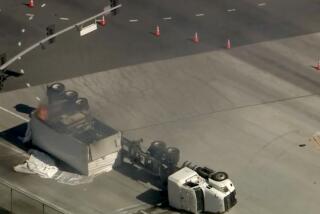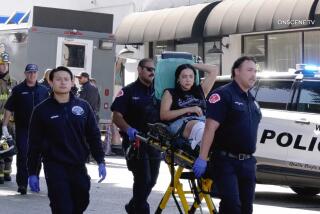Authorities offer clues in the case of bicyclist crushed by shipping container
It has the look of a freak occurrence, tragically amplified by timing: A truck is traveling a well-worn industrial area when its cargo, a shipping container, clips the bottom of a railroad bridge.
At that very moment, to the right of the truck, Robert Castorena is riding his bicycle. The container slips off the truck and lands on Castorena, 51, crushing him to death.
A day after the accident early Tuesday evening, investigators were tight-lipped as they tried to unravel the reasons behind the tragedy along the Carson-Long Beach border on Santa Fe Avenue.
Deputy Geoff Lidman, an investigator with the traffic detail at the sheriffâs Carson station, said investigators inspected the bridge, finding scrapes underneath but no serious structural damage. The truck managed to drive under the bridge â which is 14 feet and 5 inches tall â and the container also made it to the other side, suggesting that it did not squarely strike the vertical surface of the bridge.
âThe top of the container that was attached to the chassis did strike the bridge,â Lidman said. âThe force of that collision caused the fastening straps on the container to break.â
Lidman said the driver âthought the container was shorter than it was.â
The truck belonged to Western Pride Inc. in Cedar City, Utah. No one answered a call to the company for comment.
The accident happened north of the 405 Freeway next to a shipping container yard on a stretch of road that is a designated route for truckers, according to Carson and Long Beach maps.
The Los Angeles County Sheriffâs Department is investigating the accident. There have been no announcements about whether the truck driver will face criminal charges.
Teamster officials said the driver was operating a flatbed truck, which uses straps to secure a load, as opposed to a chassis that locks cargo down.
âA properly maintained chassis that is properly attached is going to be the safest way to move one of these very heavy containers,â Teamsters union spokeswoman Barbara Maynard said.
The containers are typically 12 to 14 feet high on a chassis, she said, from the ground to the top.
Maynard said that whether the driver was an independent contractor or a company employee may also be key.
âA legitimate independent contractor would determine his own route,â she said. âA dispatcher tells employees where to go and what route to take and where they go and when they get back.â
Duane DeBruyne, spokesman for the Federal Motor Carrier Safety Administration, said both types of trucks are compliant with safety codes as long as they are properly secured.
More important than the type of truck, he said, is how fast the driver was traveling and the angle of the collision.
Tuesdayâs crash was extremely unusual, DeBruyne said.
âThis is the first time Iâve heard of such a case where a shipping container was dislodged in a bridge strike. Iâm sure itâs occurred before,â he said. âI have not heard of a shipping container, regardless of chassis or flatbed, falling after striking a bridge.â
Accidents involving large trucks rarely result in death, data from the safety administration show. Of about 327,000 police-reported crashes involving large trucks in 2013, 1% resulted in death and 21% resulted in nonfatal injury. Most fatal crashes involving large trucks occur on rural roads.
Single-vehicle crashes â including those that involved a bicyclist or pedestrian â made up 22% of all fatal crashes and 14% of all injury crashes involving large trucks in 2013, the agency said.
Two years ago, the agency developed and promoted a visor card to remind commercial truck and bus drivers to use professional-grade GPS devices â rather than consumer-grade ones â which notify drivers of any obstructions in a route while flagging bridge heights.
âIt is the driverâs responsibility to plan their route appropriately, and that includes consideration of the height restrictions that they may be encountering on the route,â DeBruyne said.
More to Read
Sign up for Essential California
The most important California stories and recommendations in your inbox every morning.
You may occasionally receive promotional content from the Los Angeles Times.












